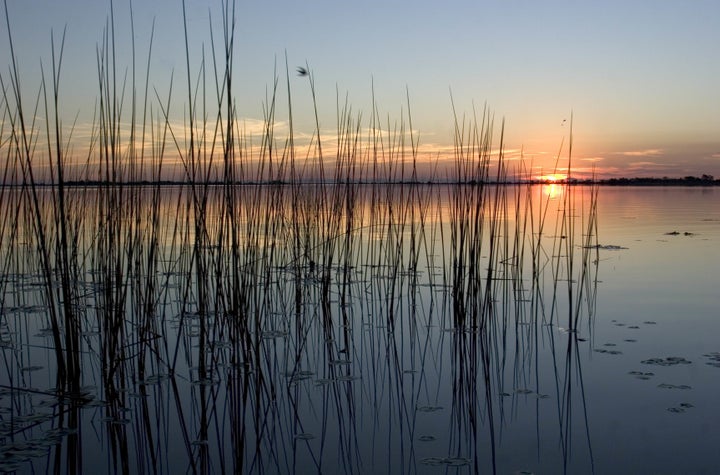
Mariana Eliano via Getty Images
Tucked away in the shelter provided by the meadow, Jurumina is fast asleep, coiled like a fireman’s hose. Even her long anteater snout seems made for putting out fires. But nothing seems to disturb her in the Iberá, a landscape shaped by estuaries that this creature blends so well into. Her natural connection to these bird-thronged surroundings is a picture postcard that, until recently, belonged to the realm of memory. For Jurumina’s species had been wiped out in this flood-prone land where camalotes bloom with purple flowers. If Jurumina can now curl up to sleep and then get up to feed off termites scurrying nearby, it is because she is part of an ambitious experiment, the first of its kind in the Americas, organised by a team of Argentine and international scientists. They plan to bring together all the pieces of the jigsaw that the life of this vast wetland represents: it has been left damaged, fragmented and, in many cases, deliberately destroyed.
Only South Africa has carried out large scale reintroductions of animals. What is happening in the Iberá wetlands is setting a precedent in Argentina and many other countries. The technical term is ‘rewilding’. Practically speaking, it means giving the environment back its original functions. In his San Alonso ranch, the biologist Ignacio Jiménez explains that you cannot divorce the landscape from its living inhabitants. And he claims that under the same bio-physical conditions – that is, the availability of water and the climate – an environment transforms according to the inhabitants that it supports. In simple terms, the geography of a place will change according to whether or not it contains giraffes. And the landscape of the Iberá has been visibly impoverished by the absence of its charismatic critters. Their return will generate more woodland and better meadows. Both have a key role because they sequester carbon from the atmosphere (the principal cause of climate change): one absorbs it, while the other fixes it in the soil and converts it into peat.
“Achieving a fully functional ecosystem means re-introducing large carnivores and herbivores. Rewilding says ‘let’s bring them back’,” Jiménez tells us. He works for the NGO Conservation Land Trust, established by US philanthropist Douglas Tompkins.
The project has a motto, “Corrientes vuelve a ser Corrientes” or, loosely translated, “Corrientes province is going back to how it was.” The province has been covered with posters featuring this slogan, because it is definitely society as a whole that will benefit from the restoration of its wildlife. The Iberá wetlands are today a mecca for eco-tourism because of its fabulous birds, capybaras, alligators and Cayará monkeys, among other animals.
“If we succeed here, in 30 years’ time this whole area will be full of life,” Jiménez says excitedly. “The Iberá will be home to woodland creatures that can serve as a tourist attraction. It is an historic opportunity to lessen a very real crisis. We have a trickle of species losses that we cannot make up for. Rewilding will generate better numbers.”

DANIEL GARCIA via Getty Images
Tobuna. The sun has barely emerged from the horizon when a group of peasants comes into view, driving a JCB with an air of triumph. Their work is to continue the construction of gigantic pens that will shelter a new generation of jaguars until they can be released. The pens of San Alonso, the most isolated point of the Iberá wetlands, have the look of a chemical molecule when seen from the air, with their four interconnected cages, each 120 square metres large. Inside live two females (the first to arrive is called Tobuna; she is magnificent) and two males. Once the females are pregnant, they will be moved to bigger pens – around 1.5 hectares – where their young will be out of sight of humans. They will be left live prey so that they learn how to hunt. Once they have reached maturity, they will be separated from their mothers and will go on to an even bigger pen, 30 hectares large. Everything works well in theory. “We still have to see if the reality corresponds to our ideas,” Jiménez admits.
One of the first species to return to the Iberá wetlands were the anteaters. They come from different areas, where many local people bring them up alongside their dogs. Girls find the baby anteaters affectionate and loving, but the critters stand no chance of surviving in a household environment. “For this reason it is very important to work together with local communities,” says the biologist Alicia Delgado, head of the Rescue Centre in the Riachuelo area, where they undergo an obligatory quarantine before their relocation. “The anteater is neither herbivore nor carnivore. It is an insectivore. It fulfils a specific role in the food chain, as insect eater and as prey to larger animals,” the scientist says. The animal became extinct in the Iberá in the 1980s. Competition with dogs, hunting and habitat loss were the factors the sealed its fate.
Translation by Simon Pickstone -- VoxEurop
This article is part of the Climate Publishers Network via Clarin.
Related on HuffPost:
